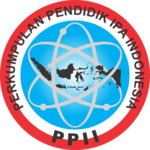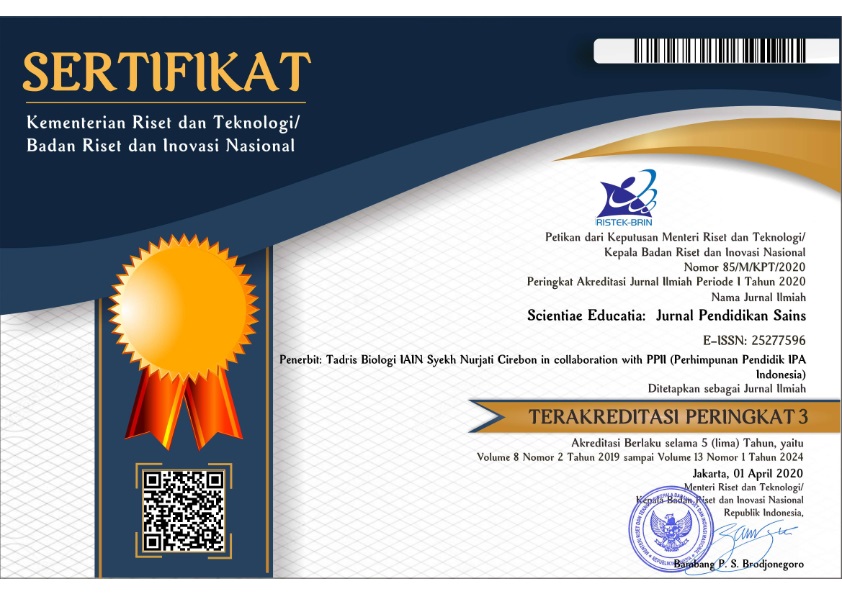Analysis of Math Teacher Candidates’ Misconception on the Dynamic Electricity Concept
(1) FKIP Unswagati Cirebon
(2) Pendidikan Biologi FTK UIN Sunan Gunung Djati Bandung
(*) Corresponding Author
Abstract
This study was intended to reveal the profile of students’ misconception of the concept of dynamic electricity in one private university in Cirebon city. In the study of physics, the misconception will hamper the achievement of physics learning goals. Misconceptions will greatly hinder the process of acceptance and assimilation of knowledge in students, so that they will hinder the success to learn more. It is necessary to conduct research on the analysis of misconception of mathematics teacher candidates on the concept of dynamic electricity. Misconception is defined as a student conception that is incompatible with the simplified conception of physicists. To identify misconceptions experienced by students, multiple-choice diagnostic tests equipped with a Certainty Response Index (CRI) can be conducted. The data obtained is then completed with interview data. This research is a descriptive research which is a research to give a description about phenomenon, or facts under study by describing the value of the variable without comparing. The study found that 81% of students’ have a misconception in the sub-chapter of electric current, and 50% in the concept of electric potential difference sub-chapter.
Keywords
Full Text:
PDFReferences
Arikunto, S. (2005). Manajemen penelitian. Jakarta: Rineka Cipta.
Arikunto, S. (2002). Prosedur penelitian suatu pendekatan praktek. Jakarta: Rineka Cipta.
Baumert, J., Kunter, M., Blum, W., Brunner, M., Voss, T., & Jordan, A. (2010). Teachers’ mathematical knowledge, cognitive activation in the classroom, and student progress. American Educational Research Journal, 47: 133-180. DOI: 10.3102/0002831209345157
Dahar, R. W. (1989). Teori-teori belajar. Jakarta: Erlangga.
Demirci, N. (2008). Misconception patterns from students to teachers: an example for force and motion concepts/Ejemplos de ideas alternativas transmitidas de los estudiantes a los profesores: temas: fuerza y movimiento. Journal of Science Education, 9(1): 55-59.
Engelhardt, P. V., & Beichner, R. J. (2004). Students’ understanding of direct current resistive electrical circuits. American Journal of Physics, 72(1): 98-115. DOI: 10.1119/1.1614813
Fajarudin, M. F. (2012). Model pembelajaran inkuiri terbimbing berbantuan website interaktif untuk meningkatkan penguasaan konsep dan kemampuan pemecahan masalah siswa kelas X pada topik listrik arus searah. [Thesis]. Bandung: Universitas Pendidikan Indonesia. Available online: http://repository.upi.edu/8887/.
Hasan, S., Bagayoko, D., & Kelley, E. L. (1999). Misconceptions and the Certainty of Response Index (CRI). Physics Education, 34(5): 294-299. DOI: 10.1088/0031-9120/34/5/304
Hermita, N., Suhandi, A., Syaodih, E., Samsudin, A., Johan, H., Rosa, F., & Safitri, D. (2017). Constructing and implementing a four tier test about static electricity to diagnose pre-service elementary school teacher’ misconceptions. Journal of Physics: Conference Series, 895(1), 012167 DOI: 10.1088/1742-6596/895/1/012167.
Hikmat, Y. R., & Yuyu, R. (2014). Strategi konflik kognitif berbantuan media simulasi virtual dalam pembelajaran fisika berorientasi pengubahan konseptual untuk meningkatkan pemahaman konsep dan menurunkan kuantitas siswa yang miskonsepsi. Pertemuan Ilmiah XXVIII HFI Jateng & DIY, 342-347.
Ismail, I. I., Samsudin, A., Suhendi, E., & Kaniawati, I. (2015). Diagnostik miskonsepsi melalui listrik dinamis four tier test. Prosiding Simposium Nasional Inovasi dan Pembelajaran Sains, Bandung, 8-9.
Kariper, A. I. (2017). Misconceptions about between physical and chemical changing of matters of primary school students. European Journal of Physics Education, 5(2), 1-5. DOI: 10.20308/ejpe.v5i2.64
Kurniawan, Y., & Suhandi, A. (2015). The Three Tier-Test for Identification The Quantity of Students’ Misconception on Newton’s First Laws. International Conference on Global Trends Academics Research (GTAR), 2: 313-318.
Kurniawan, Y., Suhandi, A., & Hasanah, L. (2016). The influence of implementation of interactive lecture demonstrations (ILD) conceptual change oriented toward the decreasing of the quantity students that misconception on the Newton’s first law. AIP Conference Proceedings, 1708 (1): 070007-–070007-5. DOI: 10.1063/1.4941180
Martyushev, L. M. (2013). Entropy and entropy production: old misconceptions and new breakthroughs. Entropy, 15(4), 1152-1170. DOI: 10.3390/e15041152
McCuin, J. L., Hayhoe, K., & Hayhoe, D. (2014). Comparing the effects of traditional vs. misconceptions-based instruction on student understanding of the greenhouse effect. Journal of Geoscience Education, 62(3), 445-459. DOI: 10.5408/13-068.1
McDermott, L. C., & Shaffer, P. S. (1992). Research as a guide for curriculum development: an example from introductory electricity. Part I: Investigation of student understanding. American Journal of Physics, 60(11), 994-1003. DOI: 10.1119/1.17003
Montecinos, A. M. (2014). Free fall misconceptions: results of a graph based pre-test of sophomore civil engineering students. European Journal of Physics Education, 5(3): 1-7.
Pelita, P. D., Suhandi, A., & Utari, S. (2011). Efektivitas penggunaan video based laboratory pada pembelajaran konseptual interaktif dalam meningkatkan pemahaman grafik dan keterampilan berpikir logis. Jurnal Penelitian Pendidikan, 2(1), 364-374.
Sangam, D., & Jesiek, B. K. (2012). Conceptual understanding of resistive electric circuits among first-year engineering students. American Society for Engineering Education (ASEE) Annual Conference and Exposition, 2012-4606
Suhandi, A., Sinaga, P., Kaniawati, I., & Suhendi, E. (2009). Efektivitas penggunaan media simulasi virtual pada pendekatan pembelajaran konseptual interaktif dalam meningkatkan pemahaman konsep dan meminimalkan miskonsepsi. Jurnal Pengajaran MIPA, 13(1): 35-48. DOI: 10.18269/jpmipa.v13i1.304
Sukardi. (2003). Metodologi Penelitian Pendidikan. Jakarta: Bumi Aksara.
Suparno, P. (2005). Miskonsepsi dan perubahan konsep pendidikan Fisika. Jakarta: Grasindo.
Surbakti, R. B. (2000). Analisis miskonsepsi siswa MA tentang konsep reproduksi sel. [Thesis]. Bandung: Universitas Pendidikan Indonesia.
Taşoglu, A. K., Ateş, Ö., & Bakaç, M. (2015). Prospective physics teachers' awareness of radiation and radioactivity. European Journal of Physics Education, 6(1): 1-14.
Tayubi, Y. R. (2005). Identifikasi miskonsepsi pada konsep-konsep fisika menggunakan Certainty of Response Index (CRI). Mimbar Pendidikan, 3(24), 4-9.
Turgut, Ü., Gürbüz, F., & Turgut, G. (2011). An investigation 10th grade students’ misconceptions about electric current. Procedia-Social and Behavioral Sciences, 15, 1965-1971.
Van den Berg, E. (1991). Miskonsepsi fisika dan remediasi. Salatiga: Universitas Kristen Satya Wacana.
Wibowo, F. C., Suhandi, A., Rusdiana, D., Ruhiat, Y., & Darman, D. R. (2016). Microscopic Virtual Media (MVM) in physics learning to build a scientific conception and reduce misconceptions: a case study on students' understanding of the thermal expansion of solids. International Conference on Innovation in Engineering and Vocational Education (ICIEVE 2015), 239-244. Atlantis Press
Wilantara, I. P. E. (2003). Implementasi model belajar konstruktivis dalam pembelajaran fisika untuk mengubah miskonsepsi siswa ditinjau dari penalaran formal siswa. Available online: www. damandiri. or. id/file/iputuekaikipsingbab2. pdf.
DOI: 10.24235/sc.educatia.v7i1.2481
Article Metrics
Abstract view : 651 timesPDF - 374 times
Refbacks
- There are currently no refbacks.
Scientiae Educatia: Jurnal Pendidikan Sains indexed by:

This work is licensed under a Creative Commons Attribution 4.0 International License.
Stat Counter (Link)



1.png)












